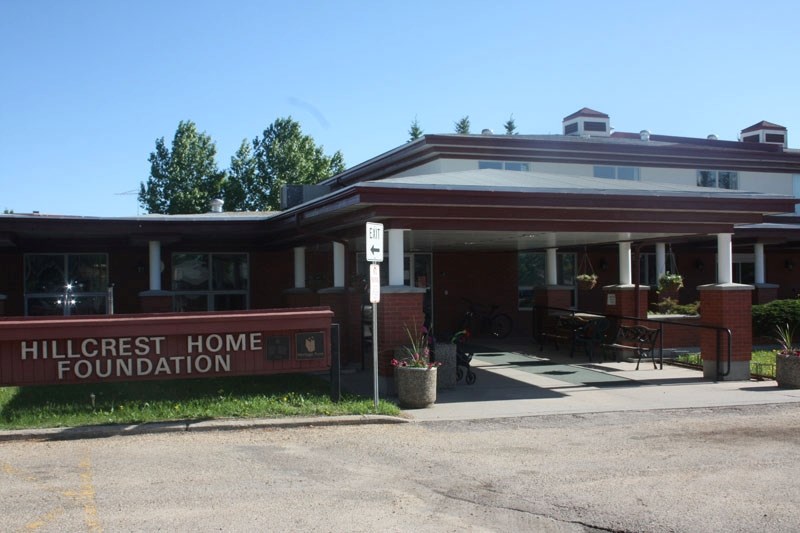A gap in Barrhead’s continuing care services is affecting more than 30 seniors, Hillcrest’s top administrator said last week.
It means some people go to Westlock, Whitecourt or Onoway to receive specialized care. Others stay at facilities in town not tailored to their needs.
The affected seniors include those with dementia or ailments that require oxygen therapy, such as emphysema, asthma and bronchitis.
“We are facing a seniors dilemma,” said Barrhead and District Social Housing Association (BDSHA) chief administrative officer Dorothy Clarke last Thursday.
She said seniors did not always want to travel outside the community, finding the move too disruptive and traumatic, particularly when their family and friends are in Barrhead.
“To some it could be a personal crisis to have to move to Whitecourt, Onoway or Westlock,” she added.
Clarke believed the dilemma could be solved if BDSHA receives funding through the Alberta government’s Affordable Supportive Living Initiative to help it build a long-awaited expansion to Hillcrest Lodge.
The project would involve building 90 units – 40 additional ones and 50 replacements. The units would meet the needs of those currently falling through the gap in services.
The architects’ drawings were ready, said Clarke. Everything was in place apart from funding.
“All we are waiting for are the eligibility requirements,” she added. “Usually, they come out in June, but because of the election it has not been decided who is responsible for ASLI grants.”
BDSHA plans to invite new MLA for Barrhead-Morinville-Westlock, Maureen Kubinec, to one of its monthly board meeting this summer to discuss seniors issues.
Clarke was speaking during Seniors Week, a province-wide celebration of seniors and their contributions to the community.
Barrhead has been marking the week with a series of events: a stuff the bus challenge for the food bank; Dale Kiselyk’s drum circle in Hillcrest Lodge; a seniors’ visit to the museum; and a 1930s and 40s swing dance last Friday.
At last Tuesday’s Barrhead County council meeting, Councillor Darrell Troock spoke of the problems facing seniors.
He said Barrhead needed to address a shortage of seniors housing. This was a pressing problem that should take priority over such issues as a new aquatic centre.
“I think this is far more important,” he said.
BDSHA provides housing at Hillcrest Lodge (91 units); Klondike Place (40 suites); Jubilee Manor (16 units); Golden Crest (32 units); Pembina Court (24 units) and James and Della Roach Manor at Fort Assiniboine (six units).
Clarke said there were 40 on the waiting list for Hillcrest and Klondike, a more or less static number over recent years. The waiting list for Jubilee and Golden Crest was the same.
“All the beds at Hillcrest are currently occupied, apart from one small room which will be filled within a week,” she said.
A continuing care centre concept has recently been drawn up for the Barrhead area, fitting a model put forward in February by Alberta Seniors (now part of Alberta Health Ministry) and Alberta Health and Wellness, with some input from Alberta Municipal Affairs.
It identifies four types of care that should be provided. Barrhead offers facilities for three of them: long-term care (Keir Care Centre); designated assisted living (level 4), including a nurse on staff and on call 24 hours a day (Shepherd’s Care); and designated assisted living (2), including a nurse on staff less than 24 hours (BDSHA facilities, Hillcrest, Klondike Place, Jubilee Manor and Golden Crest).
The one type of care Barrhead does not provide for is designated assisted living (3), catering for residents with serious needs. This requires a licensed practical nurse and/or health services aide on staff 24 hours a day.
“I would say 30 to 40 people in Barrhead fall into this category,” said Clarke. “Probably nearer the 30 mark.”
Clarke foresaw the problem lingering or intensifying over the next few years until the next generation of seniors, who would be more independent and active.
“Their needs are going to be different,” she said. “They are going to require Internet access and be going out canoeing, hiking and jeeping.”
It was important for administrators to begin planning now for this new generation, as well as dealing with today’s seniors, said Clarke.
As people live longer, health costs are going to go up, presenting huge social challenges.
According to a 2011 census released by Statistics Canada, the number of seniors aged 65 and over in Canada increased 14.1 per cent to nearly five million, a faster rate of growth than that for children aged 14 and under (0.5 per cent) and people aged 15 to 65 (5.7 per cent).
Seniors accounted for a record high of 14.8 per cent of the Canadian population in 2011, up from 13.7 per cent five years earlier.


.jpg;w=120;h=80;mode=crop)
